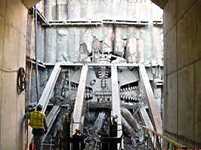DECOMPRESSION SICKNESS AND TUNNEL WORKERS

Courtesy of Port of Miami
Overview
Underwater construction and tunnel operations use compressed air to stabilize soil and keep out water. In these conditions, workers are at risk of decompression sickness (DCS).
DCS can be treated or prevented using a decompression chamber guided by decompression tables. The tables direct the time and pressure intervals needed to ensure workers are brought back to surface pressure safely.
This web page provides information about decompression sickness and the NIOSH decompression tables. These tables are accessible for use by workers, employers, and safety and health professionals.
Background
What is Decompression Sickness (DCS)?
DCS, also called the "bends," occurs when not enough pressure is released from the body following exposure to increased pressure. DCS is more commonly noted among scuba divers, but also occurs among those working in conditions that use compressed air, like tunnel construction.
Moving too quickly from an area of high pressure to low pressure can produce nitrogen gas bubbles in the body. If outside pressure is released too quickly, the gas is released in the body. Just like uncorking a bottle of soda, there is a sudden expansion of bubbles or "fizzing." Nitrogen bubbles in the blood or tissues can obstruct blood flow or cause pressure effects. This can be very painful and sometimes fatal.
Symptoms of DCS may include:
- joint pain
- areas of bone destruction (termed dysbaric osteonecrosis)
- skin disorders, such as cutis marmorata, which causes a pink marbling of the skin
- spinal cord and brain disorders, such as stroke, paralysis, paresthesias, bladder dysfunction, etc.
- cardiopulmonary disorders, such as shortness of breath
- arterial gas embolism (gas bubbles in the arteries that block blood flow)
How is DCS prevented?
A decompression chamber is used to gradually bring workers back to normal surface pressures. Decompression tables detail the time and pressures needed to do this safely. The pressure changes and time intervals defined in the tables are chosen based on the worker's exposure pressure and work shift length.1
The first decompression tables were developed by Haldane for the British Admiralty in 1908. Other tables have since been developed. In 1971, the Washington State Decompression Tables became the federal code enforced by the Occupational Safety and Health Administration (OSHA).2 These tables were included in OSHA Standard 1926 Subpart S Appendix A and remain unchanged today.



Courtesy of the U.S. Department of Energy (photo #1), Courtesy of NAVY.com (photo #2), Courtesy Minnesota Department of Transportation (photo #3)
Limitations of the Current OSHA Decompression Tables
Many factors indicate that the OSHA decompression tables need updating.2, 3 More information is available on the link to the Limitations of the Current OSHA Decompression Tables .
The NIOSH-developed Decompression Tables
In the 1980s, Dr. Eric Kindwall and Mr. Peter Edel were given a NIOSH contract to develop stepwise (staged) tables. These new tables, known as the Edel-Kindwall Caisson Tables, underwent both lab and field testing. This effort was summarized in a final report submitted to NIOSH entitled: Criteria for Interim Decompression Tables for Caisson and Tunnel Workers [PDF - 17,353 KB]. 4 This Report provided four new Decompression Tables. The Tables are available individually here: NIOSH-developed Edel-Kindwall Decompression Tables . The NIOSH developed tables also have limitations: more information is available at the same link.
References
- Hamilton RW Bill, Kay E. (2008) Boring deep tunnels. Third conference on U.S. – Japan panel on aerospace-diving physiology & technology and hyperbaric medicine.
- Downs GJ, Kindwall EP. (1986) Aseptic necrosis in caisson workers: A new set of decompression tables. Aviat Space Environ Med 57:569-574.
- Kindwall EP. (1997) Compressed air tunneling and caisson work decompression procedures: development, problems, and solutions. Undersea Hyper Med 24:337-345.
- Kindwall E, Edel P [1981]. Criteria for interim decompression tables for caisson and tunnel workers. Milwaukee, WI: Sea-Space Research Co., Inc. NIOSH contract no. 210-80-0110 for NIOSH Office of External Coordination and Special Projects.
- Page last reviewed: June 18, 2012
- Page last updated: September 19, 2012
- Content source:
- National Institute for Occupational Safety and Health Education and Information Division


 ShareCompartir
ShareCompartir